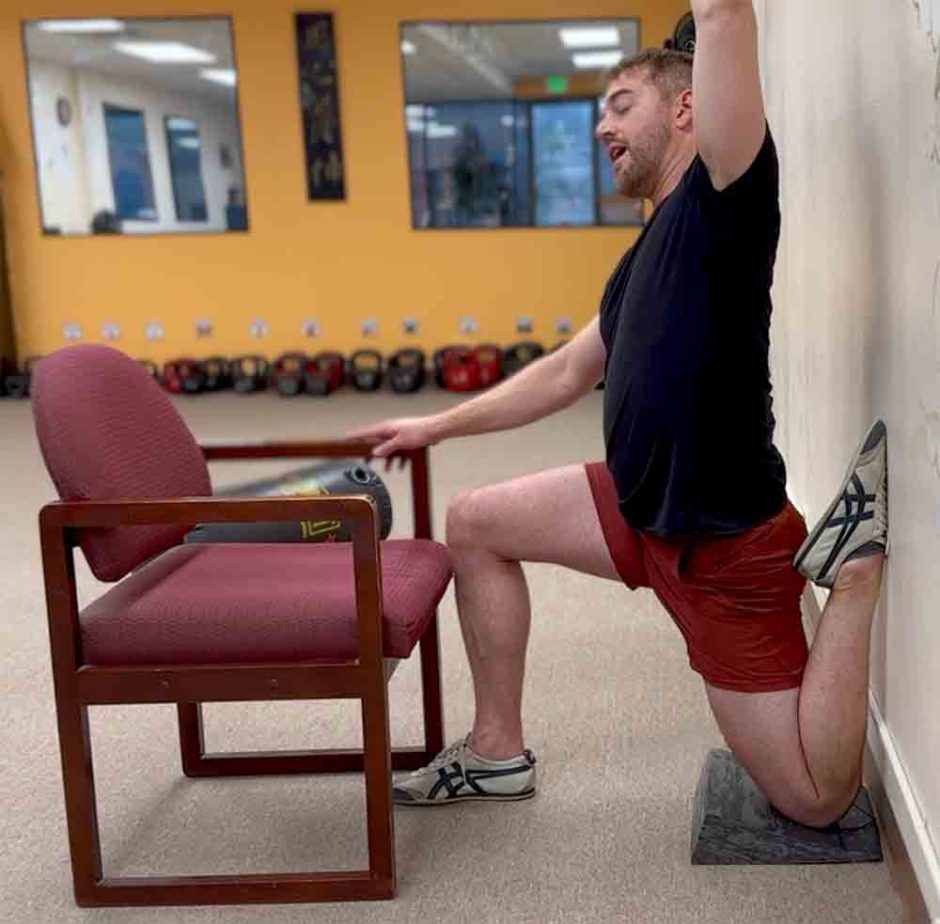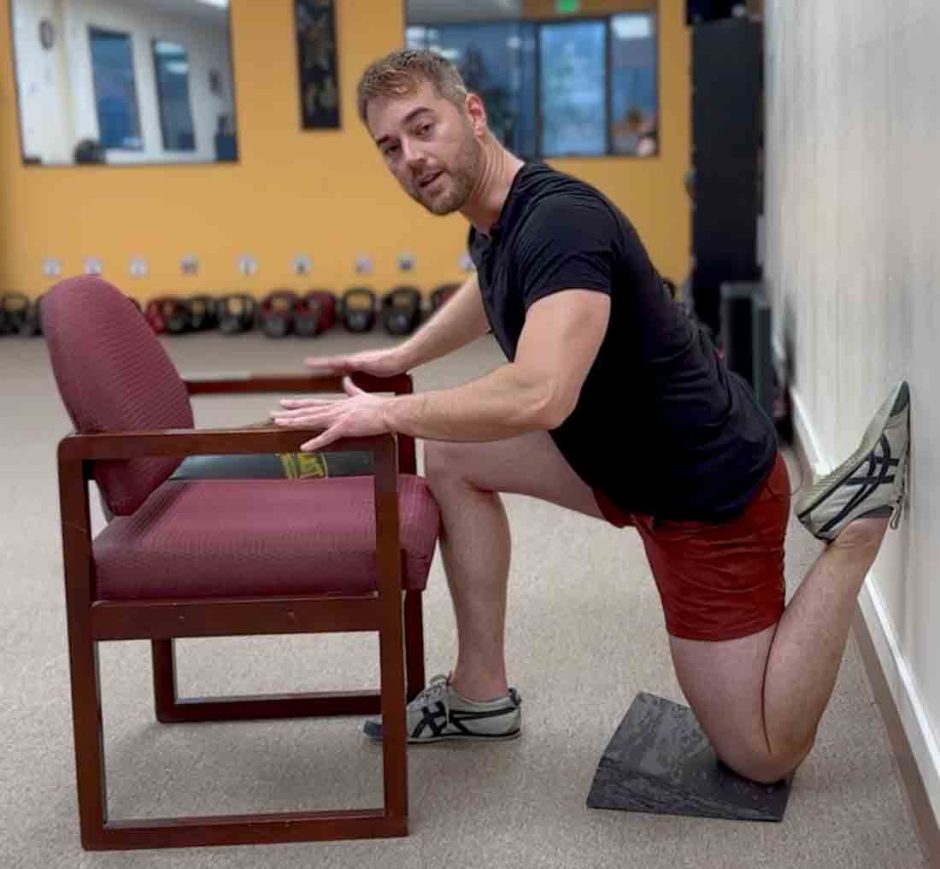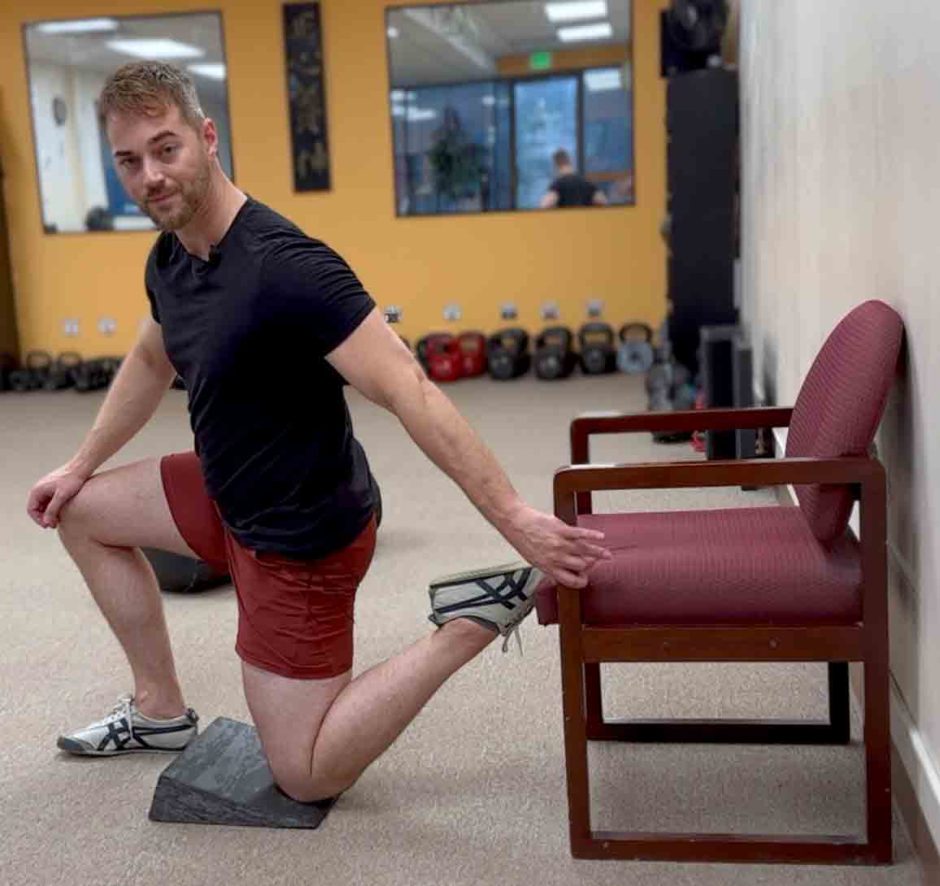Stiffness & Pain in the Low Back & Knees
According to Georgetown University’s Health Policy Institute nearly 65 million Americans reported a recent incident of back pain. Some 16 million adults report consistent low back pain.
Pain isn’t just annoying it prevents you from experiencing an abundant life. It negatively impacts your mood, happiness, and enjoyment of life.
You don’t feel like running, jumping, playing, and being athletic.
And of course it could really sap your desire to get into a martial arts class and train.
While low back pain can have a number of causes the single most common cause comes from tight and weak hip flexors and quadriceps muscles.
Most Americans sit for the majority of the day and this hip flexed and knee flexed position can really cause some chronically tight hip flexors and quadriceps muscles which can lead to stiff and achy low backs.
But it can also lead to chronic knee pain.
Patellofemoral Pain Syndrome
Otherwise known as chronic knee pain. Most typically felt just below and/or on the outside of the patella of the knee.
It has been called jumper’s knee, runner’s knee, office worker’s knee, theater knee and more.
Most people believe that they have some sort of knee degeneration and that “their knees are going out” whatever the heck that non-scientific term means.
They might even go to a doctor and an MRI will show degeneration of the meniscus and other cartilage of the knee. The doctor will tell them that the only solution is a knee replacement. God-forbid don’t make that mistake.
At least until to you try the following stretch for a month or two.
Numerous studies have shown an absolute ZERO correlation between how chewed up someone’s knee cartilage is and knee pain yet the medical industry still recommends knee replacements…
Isn’t that like going to a car salesman and asking him if he thinks you need to buy a new car?
The reason it is called patellofemoral pain syndrome is because it affects the patella… which is near the femor… you have pain… and syndrome is a medical word for “we don’t know why.”
Well in my journey out of patellofemoral pain syndrome what I discovered was that my quadriceps muscles where chronically tight which pulled on the tendons of my patella. That chronic pulling irritated the area causing pain.
The chronic pain also caused weakness in my quad muscles which made me avoid exercising them so the condition just spiraled worse and worse.
Until I discovered the couch stretch.
By the way… 10+ years of low back pain. At least 4 years of chronic knee pain. All gone in about a month. And I wasn’t even doing this stretch daily.
Low Back Degeneration
Ditto for our rugged and robust lower backs.
We either assume we have some sort of genetic malfunction in our back that means we are bound to our fate of low back pain.
Or we go to a doctor who shows us MRIs of herniated discs, degenerated discs, spondylolisthesis, pinched nerves, etc.
Once again there are numerous studies that prove that none of those conditions are the cause of low back pain. Multiple studies show that upwards of 80% of people actually have those conditions but they don’t feel pain. And just about the same percentage (roughly 80%) of people who have pain don’t have any of those conditions.
That doesn’t mean that you won’t have those conditions if you have pain… it just means that they may not really matter when it comes to getting pain-free and healthy.
I can’t make this stuff up you can find it yourself if you are willing to go dig through research (not articles like this one… this is not a published research paper by a team of PhDs… this is a “how to” article.)
But for now let’s assume what I am saying is true and give the following stretch the good old college try for a month or two and see if you don’t feel better.
Surgery or a life of self pity will always be an option.
By the way as I had mentioned earlier there can be multiple causes of low back and knee pain so the following stretch will not address all of them but it will address most of them.
Knees Over Toes & Supple Leopard
I want to give a big shout out to Ben Patrick and Kelly Starrett for introducing or at least popularizing the couch stretch.
I also highly recommend their YouTube channels for anyone wanting to improve pain-free range of motion and regain your feeling of athleticism.
In the past when I had pain in my knees and stiffness in my low back I had played around with stretching my quads by laying on my side and using a band to pull my foot behind me.
The position was essentially the couch stretch but I didn’t stay consistent with it.
Are you listening? I didn’t stay consistent with it so the results didn’t stick.
If you are ready to get out of pain and chronic tightness? Then you must dedicate yourself to it.
The Couch Stretch aka Quad / Hip Flexor Stretch
You are about to get into the position shown below. Get set up and ready and then slowly move into position by following the instructions that follow.
Have something squishy under your knee especially if you have knee pain. A pillow will work.
You will need something to hold onto for balance and to lean forward against to reduce the stretch, especially in the beginning.
Put your knee on the squishy thingy facing sideways to a wall or whatever sturdy thing you can prop your foot against.
Now turn your body so you are facing away from the wall (as shown in the photo) as your foot slides up the wall. You will no doubt need to lean forward to create space to squeeze your foot between yourself and the wall.
Now simply lean backwards until you feel the desired amount of stretch (a level 3 out of 10).

This will no doubt be too intense for most people so utilize the following regressions.
1) Move your knee further from the wall. The more space you make the less stretch on the quad.
2) Also the closer your heel is to your butt the more intense the stretch. So you can move your butt further from your heel when you are getting started.

3) You can even place your foot on a lower object. This also increases the space between your butt and heel further reducing the stretch.

4) The more you lean forward the less stretch you will feel. And the more upright the more stretch you will feel.
5) After you have been doing this for a while an advanced tip is to tuck your tailbone underneath you the way a dog would tuck it’s tail between its legs. That will REALLY increase the stretch once you are ready for it.
How to Stretch
Find a level 3 out of 10 intensity. Level 10 is HOLY CRAP and Level 1 is “meh.” So a level 3 should feel mild to moderate.
For your first month and especially if you have a history of low back pain you might want to go level 2. I mean it! You are pulling on tendons and muscles that have been irritated for a long time. They will not appreciate your tugging on them recklessly.
It is not uncommon to feel a slight tweak in your low back after doing this for a couple of days after you first start. The only way I can advise you is to go very easy, don’t push hard, and if you get a tweak in your back don’t give up and stop.
Continue the stretching but more mildly and you should notice the low back tweaks go away. It is often just part of the process and it is worth a little unpleasantness now for a completely pain-free back later.
Do this stretch every single day for 30 seconds per leg.
You could do it twice per day if you want to speed things up but don’t push harder than a level 3 for the first month.
Even after a month you never need to push super hard into stretches to make progress. Your muscle are not actually too short… you are not lengthening them per se. You are teaching your brain to stop contracting the muscles and allow them to relax further and further.
Consider this, if you were under anesthesia (or really really drunk) you could do the full splits because your brain’s reflexes are chemically turned off. Your muscle are more than flexible enough to do the splits but your brain reflexively tightens them based upon what you have trained it to do.
If you sit all of the time you have trained your brain to keep your hip flexors and quads tight. If you do a lot of long distance cycling you have really done this by adding load to the shortened positions.
No worries, you just need to spend time in more lengthened positions… such as the couch stretch.
When you first start it might feel like you are pulling on a steel cable and not getting much stretch at all. Don’t worry, just keep it mild and it will start to soften up over the course of several sessions.
By the way in the video I offer some additional tips on how to stretch such as the highly effective contract-relax method and wiggle stretching. It is worth watching.
Summary
Spend 30 seconds per day per leg.
Level 3 out of 10 stretch.
If you get a tweak in your low back don’t stop. Just continue at a more mild level of stretch. It will go away over the course of a couple of days. Often much sooner if you continue stretching.
After a month of daily couch stretches your knees and lower back should feel considerably better if not completely pain-free.
In my experience if I stop doing this stretch for too long of a period things start to get aggravated again so I just make this a part of my regular fitness program. It isn’t a big deal… 1 minute per day, c’mon, let’s go!
Until next time,
Brian
